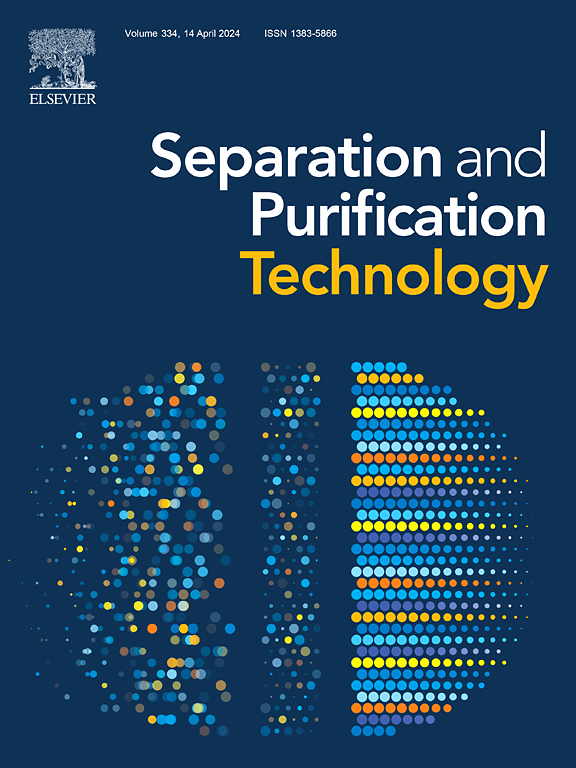Construction of underwater superoleophobic membrane by polydopamine-modified MOF with effective purification of multi-component emulsified oily wastewater
IF 9
1区 工程技术
Q1 ENGINEERING, CHEMICAL
引用次数: 0
Abstract
Superwetting membranes that exhibit distinct affinities towards water and oil hold immense promise for the removal of oil from wastewater. However, the coexistence of water-soluble pollutants and insoluble oil in real emulsified oily wastewater systems significantly escalates the complexity of purifying such wastewater. It is still a big challenge to simultaneously remove multi-component pollutants from real wastewater. Therefore, the development of superwetting separation membranes capable of both oil and pollutants is crucial for purifying multi-component emulsified oily wastewater. In this work, we developed a PDA@ZIF-8/Nylon composite membrane via vacuum-filtering polydopamine-coated ZIF-8 nanoparticles onto nylon substrate membrane for multi-component emulsified oily wastewater purification. The introduction of polydopamine-modified ZIF-8 nanoparticles endowed the composite membrane with underwater superoleophobicity and negative surface charges, which facilitates the superwettability-induced oil removal and electrostatic interaction-mediated pollutants removal. The composite membrane exhibited excellent oil removal performance for various emulsifier-stabilized O/W emulsions with excellent recyclability and continuous separation performance. In addition, the oil and dye in the dye emulsion were simultaneously removed. Further application potential studies found that the removal and reduction of Au (Ⅲ) from gold-containing wastewater was achieved based on phenolic hydroxyl groups on the membrane surface, extending the application of membrane separation technology for gold recovery. It was worth mentioning that the composite membranes exhibit excellent antifouling ability, long-term stability, chemical stability, and light-induced self-cleaning properties. This work offers new insights into fabricating superwetting membranes for multi-component emulsified oily wastewater purification.


聚多巴胺改性MOF构建水下超疏油膜,可有效净化多组分乳化含油废水
超湿膜对水和油具有明显的亲和性,在去除废水中的油方面具有巨大的前景。然而,在真实的乳化含油废水系统中,水溶性污染物和不溶性油的共存大大增加了这类废水净化的复杂性。如何同时去除实际废水中的多组分污染物仍然是一个很大的挑战。因此,开发兼具油污和污染物双重功能的超湿分离膜是净化多组分乳化含油废水的关键。在本研究中,我们通过真空过滤聚多巴胺包被ZIF-8纳米粒子到尼龙基膜上,开发了PDA@ZIF-8/尼龙复合膜,用于多组分乳化含油废水的净化。引入聚多巴胺修饰的ZIF-8纳米粒子使复合膜具有水下超疏油性和表面负电荷,有利于超润湿性脱油和静电相互作用介导的污染物去除。复合膜对多种乳化剂稳定的油水乳状液具有良好的除油性能,具有良好的可回收性和连续分离性能。同时去除染料乳剂中的油脂和染料。进一步的应用潜力研究发现,利用膜表面的酚羟基实现了含金废水中Au(Ⅲ)的脱除和还原,拓展了膜分离技术在金回收中的应用。值得一提的是,复合膜具有优异的防污能力、长期稳定性、化学稳定性和光致自洁性能。本研究为制备用于多组分乳化含油废水净化的超湿膜提供了新的思路。
本文章由计算机程序翻译,如有差异,请以英文原文为准。
求助全文
约1分钟内获得全文
求助全文
来源期刊

Separation and Purification Technology
工程技术-工程:化工
CiteScore
14.00
自引率
12.80%
发文量
2347
审稿时长
43 days
期刊介绍:
Separation and Purification Technology is a premier journal committed to sharing innovative methods for separation and purification in chemical and environmental engineering, encompassing both homogeneous solutions and heterogeneous mixtures. Our scope includes the separation and/or purification of liquids, vapors, and gases, as well as carbon capture and separation techniques. However, it's important to note that methods solely intended for analytical purposes are not within the scope of the journal. Additionally, disciplines such as soil science, polymer science, and metallurgy fall outside the purview of Separation and Purification Technology. Join us in advancing the field of separation and purification methods for sustainable solutions in chemical and environmental engineering.
 求助内容:
求助内容: 应助结果提醒方式:
应助结果提醒方式:


